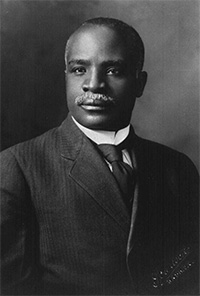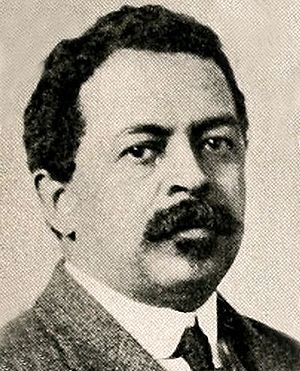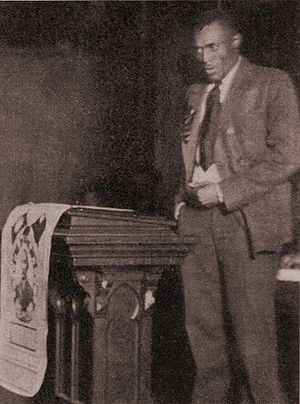Negro Sanhedrin facts for kids
The Negro Sanhedrin was a big meeting held in Chicago, Illinois, from February 11 to 15, 1924. It was called an "All-Race Conference" because it brought together many different African American groups. About 250 people attended, representing 61 organizations. The goal was to create a plan to protect the rights of African-American farmers and workers. They also wanted to expand civil rights for all Black people in America.
Contents
History of the Sanhedrin Meeting
How the Idea Started
The idea for this national meeting came about in the spring of 1923. This was after a law called the Dyer Anti-Lynching Bill failed to pass in the United States Congress. This bill would have made lynching (a type of violent attack) a federal crime.
William Monroe Trotter from the National Equal Rights League (NERL) in Boston first suggested the idea. He wanted a national council of important Black leaders to come together. He shared his idea with Matthew A. N. Shaw, who was the president of the NERL. Shaw then invited five other groups to support the conference.
One of the groups asked was the African Blood Brotherhood (ABB). This was a group with strong, different ideas, linked to the Workers Party of America. Cyril Briggs, who led the ABB, helped organize the meeting. He first called it a "United Front Negro Conference of Civil Rights Organizations."
On March 24, 1923, six groups officially agreed to support the conference. These included the ABB, NERL, National Association for the Advancement of Colored People (NAACP), International Uplift League, Friends of Freedom, and the National Race Congress.
Dean Kelly Miller from Howard University was chosen to lead the planning committee. He represented the National Race Congress. Cyril Briggs continued to handle the daily organizing tasks as secretary. They spent almost a year planning and reaching out to other groups. Miller helped connect with more common community and club organizations. He also chose the name "Sanhedrin" for the meeting. This word comes from an old book called 1 Maccabees and means a top council of the Hebrew people.
The Chicago Convention
The Sanhedrin meeting began in Chicago on February 11, 1924. There were 250 people attending, representing 61 different groups.
The groups at the meeting had many different ideas. Some were more traditional civic groups, while others, like the African Blood Brotherhood, had very strong, new ideas. Many delegates were professionals, scholars, and businesspeople from over 20 different American states.
Because of this mix, the meeting was not very radical. After a short discussion, the delegates chose Kelly Miller as their chairman. Some delegates with more radical ideas, like Briggs and his friends from the Workers Party, Lovett Fort-Whiteman, and Otto Huiswoud, did not agree with this choice.
What They Wanted to Achieve
Lovett Fort-Whiteman spoke at the meeting for the delegates with more radical ideas. These included Communists and members of the ABB. He wanted the meeting to agree on several things. These included ending racial segregation (keeping races separate) in housing. He also wanted to end colonialism (when one country controls another) in Africa. Other goals were to have legal contracts to protect tenant farmers (farmers who rented land). He also wanted to get rid of anti-miscegenation laws (laws against marriage between different races). Finally, he wanted the United States to officially recognize Soviet Russia.
They also prepared ideas to criticize the American Federation of Labor. This group allowed its member unions to keep Black workers from joining. They also wanted African Americans to join the Farmer-Labor Party, which was supported by Communists.
However, the chairman, Kelly Miller, did not let these radical ideas take over. He appointed an official from the Chicago Chamber of Commerce to lead the Sanhedrin's Labor Committee. This meant the ABB and its allies had to bring their ideas directly to the main meeting. This process did not work for their ideas about school segregation, opposing the Ku Klux Klan, or recognizing Soviet Russia.
The ideas that did pass were much milder than what the radical groups wanted. For example, instead of strongly criticizing the leaders of the American Federation of Labor, they gave a gentle warning to local unions for not letting Black members join. They also supported equal pay for all workers, no matter their race. And they wanted to help farmers who were struggling during a tough economic time.
The Sanhedrin meeting ended on February 15, 1924.
What Happened After
The Negro Sanhedrin was the first national meeting of Black Americans where members of the Communist movement openly took part. Some people thought it was a great chance for different Black organizations to work together. They hoped to put aside their differences and create a plan that would help everyone.
However, the Sanhedrin did not succeed in this. The Communist groups' actions in Chicago caused a lot of disagreement. Because of this, they were not allowed to attend a later meeting held in Washington, D.C..
The Sanhedrin movement also did not become a lasting way for different Black organizations to work together. The energy from the Chicago meeting quickly faded away.




